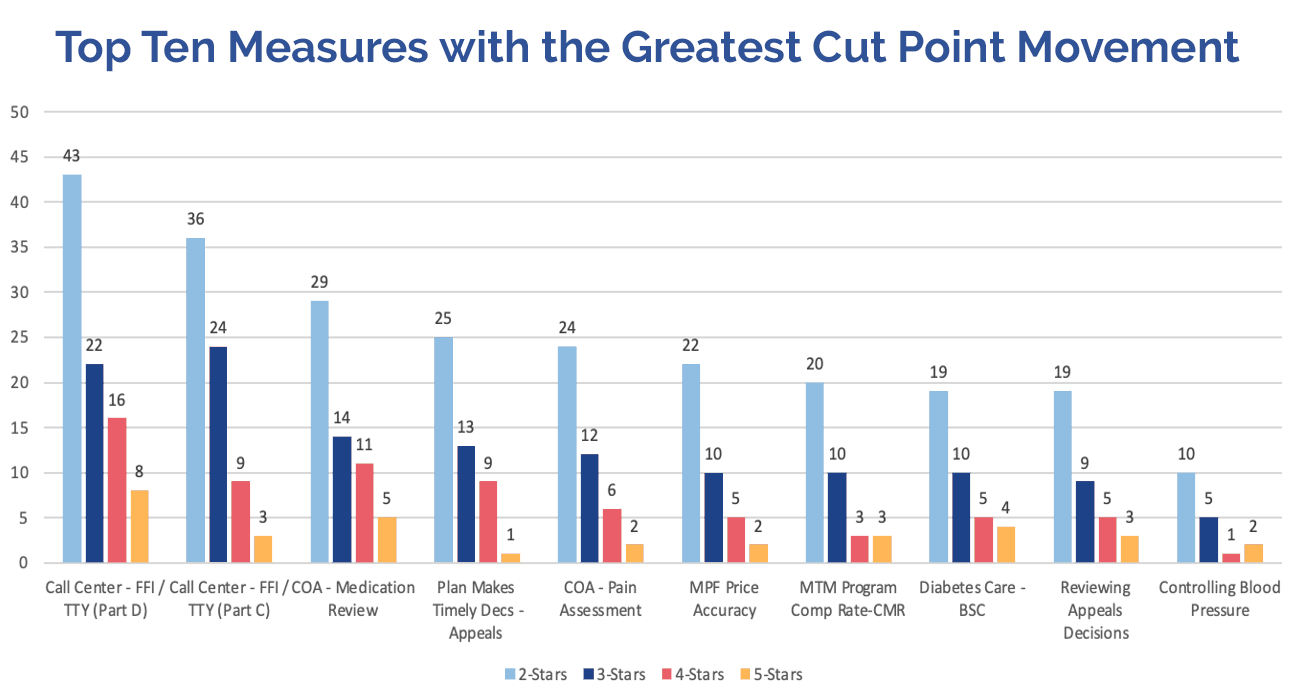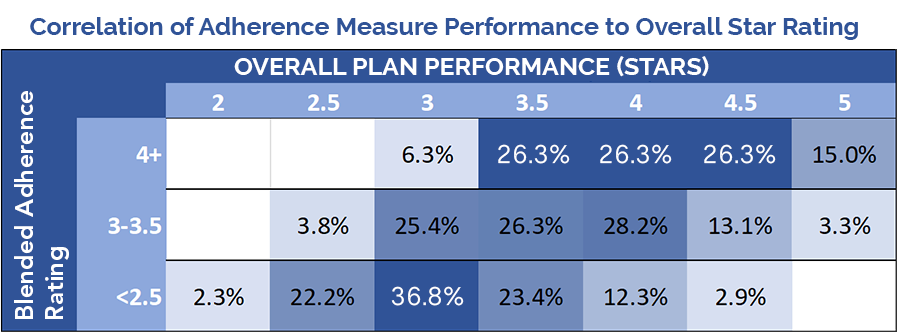News
Article
Contributor: The Stars Have Realigned (Again)—What Medicare Advantage Plans Need to Know
Author(s):
Understanding of changes in CMS' Star Ratings criteria will help Medicare Advantage plans to address all changes with confidence.
Medicare Advantage (MA) plans just saw 1 of the most significant drops in Star Ratings in recent years. More than half (58%) of MA plans earned less than 4.0 Stars for 2024, and as a result, will lose access to coveted quality bonus payment dollars.
With the new year now underway, the annual challenge to earn a 5-star rating is back on. Once again, new and anticipated changes could have a massive impact on scoring. But with so many plans starting at a disadvantage, it is more important than ever to fully understand all the new expectations from CMS.
Here is an overview of what’s new, and advice for what MA plans should focus on in the coming year to maximize their chance of Star Ratings success:
1. The Tukey Outlier Deletion: Starting from the 2024 Star Ratings, CMS introduced the Tukey Outlier Deletion method, aimed at removing measure scores falling outside established upper and lower thresholds from cut point determinations. As more outliers typically exist on the lower end of a measure, this method tends to affect 2- and 3-Star cut points much more significantly than those at the higher end of the Stars scale. Consequently, many 2- and 3-Star cut points increased by 10 or more points compared with the 2023 Star Ratings. Moreover, the application of the Tukey Method before the implementation of guardrails led to cut points higher than anticipated, resulting in what was likely lower-than-expected Star Ratings for many plans.
“Although cut points will only experience the Tukey effect once—for the 2024 Star Ratings—and then should stabilize going forward, some MA plans dropped so far in certain measures that it will take years just to get back to where they were,” said Rex Wallace, CEO of Rex Wallace Consulting.
For this reason, a solid Stars strategy is critical, and plans may want to focus on 7 measures that saw cut point increases of more than 20 basis points from 2023-2024. An analysis by Hyperlift shows that these include:
- Call Center - Foreign Language Interpreter and TTY Availability (Part D)
- Call Center - Foreign Language Interpreter and TTY Availability (Part C)
- Care for Older Adults (COA) - Medication Review
- Plan Makes Timely Decisions About Appeals
- Care for Older Adults (COA) - Pain Assessment
- MPF Price Accuracy
- MTM Program Completion Rate for CMR
Top Ten Measures With the Greatest Cut Point Movement | Image credit: AdhereHealth

2. Health Equity Index (HEI): CMS has introduced the HEI for measurement years 2024-2025, emphasizing the importance of improving member health outcomes to address health equity. Starting from the 2027 Star Ratings, plans meeting performance standards on selected measures (identified annually by CMS) will qualify for a reward payment under the HEI, replacing the previous reward factor.
Eligibility for the HEI is limited to certain MA contracts based on the presence of members having specific social risk factors (SRFs), such as dual eligibility for Medicare and Medicaid, or enrollment due to disability. Qualified contracts must meet criteria regarding member numbers, SRF presence and comparative performance within the industry. The HEI score determines points earned, with contracts ranked and divided into thirds based on performance. Scoring above 1 will result in points added to the overall Star Rating.
As MA plans get acclimated to the HEI and anticipate its impact on their overall Stars performance, CMS has released contract-level reports that include, among several details, the subset of measures that may fall under the HEI. In preparation for success, it’s important for plans to understand their historic performance on these identified measures.
In addition, it’s critical to focus efforts on the 3 triple-weighted adherence measures for hypertension (RAS antagonists), cholesterol (statins) and diabetes. Within the Star Ratings, these measures have a “force multiplier” effect on other related and heavily weighted measures, and therefore the overall Star Rating. Within the HEI, their relative weight is also critical. When compared with the smaller subset of HEI measures, their triple-weighting provides even more impact as part of the HEI score. By tracking past performance on these influential measures and placing focus on improving performance going forward, plans can improve not only their HEI score, but also their overall Star Rating.
Correlation of Adherence Measure Performance to Overall Star Rating | Image credit: AdhereHealth

3. Quality Improvement (QI) “Hold Harmless” provision:
Depending on how it is finalized by CMS, experts agree the changes to the QI Hold Harmless provision (currently only proposed) could have an immense impact on MA plans at every performance level within the Star Rating.
“The proposed change to the QI Hold Harmless provision will be the most substantial financial change that CMS has ever implemented. This change, coupled with the removal of the Reward Factor, will mean that EVERY plan needs to have a focused and detailed plan to manage QI performance throughout the year,” said Mick Twomey, CEO of Hyperlift.
Currently, the Hold Harmless provision prevents MA plans from being hurt by the 2 5x-weighted QI measures (Part C Health Plan Quality Improvement and Part D Drug Plan Quality Improvement) if the plan achieves an overall Star Rating of 4.0+ Stars. Essentially, the takeaway is that high-scoring 4-plus-Star plans don’t have as much room for improvement, so their scores on the 2 QI measures might be lower than for other plans. Thus, if those measures counted, they could negatively impact the overall Star Rating. However, CMS appears to be sending the message that 4-Star plans do indeed have room for improvement, in that it has proposed to shift the provision to only protect 5-Star plans.
Not only would this change the definition of a “high-performing” plan, it would challenge plans that currently rely on being “held harmless” to improve their Star Ratings performance. Plans will need a process in place to track performance on the 2 heavily weighted QI measures and keep this as a key focus of the Stars strategy to avoid the substantial negative impact of low performance on these measures.
A strategy for plans is to ensure they have a deep understanding of how the QI measures are calculated and establish processes that optimize performance. It will help to understand what the QI Significant Improvement thresholds may be for each measure and keep a focus on these when managing Star Ratings performance throughout the year.
4. Proposed Part D polypharmacy and opioid measures:
Originally proposed by CMS to move from display measure status to a finalized spot in the Star Ratings for the 2024 measurement year, several Part D measures are still poised for a more permanent role in performance rating. These 3 measures (Concurrent Use of Opioids and Benzodiazepines, Polypharmacy Use of Multiple Anticholinergic Medications in Older Adults and Polypharmacy Use of Multiple Central Nervous System Active Medications in Older Adults) help MA plans identify, per CMS, “enrollees who are at risk of respiratory depression or fatal overdoses, cognitive decline, or falls and fractures, and facilitate plans to encourage appropriate prescribing when clinically necessary.”
As per CMS, the elderly and members with complex health needs are at increased risk for complications due to the potentially dangerous medications (opioids, benzodiazepines, anticholinergics and central nervous system active pharmaceuticals) addressed by these measures, the agency has proposed the measures join the Star Ratings lineup in an attempt to reduce medication errors and improve patient health and safety. Though not yet finalized, MA plans should still be prepared to address them as part of the Stars strategy.
Plans will need to be sensitive in their member engagement approach in relation to these medications, as they are frequently used to manage pain and mental health. Working directly with the prescribing provider is 1 strategy to effectively address polypharmacy and safety issues in regard to the medications. Plans will also need to establish year-round monitoring of prescription claims, since members could be prescribed the medications at any point during the year and, as a result, qualify for 1 of the measures.
By incorporating year-round claims monitoring with a provider-first approach to outreach, plans will be able to strengthen the Stars strategy to address these polypharmacy measures in preparation for their finalization by CMS.
5. Shifting member experience weights:
Though CMS had increased the weight of most Consumer Assessment of Healthcare Providers and Systems (CAHPS) surveys and other member experience measures up to 4x for the 2023 Star Rating (resulting in those measures accounting for approximately 60% of an MA plan’s total Star Rating), the agency has since adjusted the weight of those measures down to 2x for Stars 2026 (accounting for 22% of the total Star Rating). Despite this, a focus on the member experience is still vital to overall Stars success and should continue as a key initiative for MA plans.
“Our guidance to MA plans is this: close your eyes to the member experience weight reduction. Pretend these measures are still 4x-weighted and do everything you can to continually improve them. At their core, no other measures are focused on access to care or the coordination of care. If members cannot access care, they cannot close a [Healthcare Effectiveness Data and Information Set] gap, nor can they pick up their medication refill. These measures are core to a sound Stars strategy,” stated Wallace.
Also, plans must acknowledge the interconnectedness of Stars measures, for example, the Getting Needed Prescription Drugs measure. This CAHPS measure may be experiencing a weight reduction, but continued high performance on this can also influence the plan’s performance on triple-weighted adherence measures, and therefore overall Stars performance.
Conclusions
In the coming year, the demand for MA plans to enhance their Star Ratings performance and maintain competitiveness in the Medicare arena is set to rise as CMS continues to update its criteria. MA plans equipped with a comprehensive understanding of evolving requirements, along with dependable partnerships for advice and assistance, will be primed to confront forthcoming changes confidently. With a deep understanding of ongoing developments—as well as trusted partnerships for guidance and support along the way—MA plans will be prepared to address any and all changes head on.





